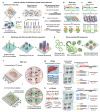Spatial Transcriptomics: Technical Aspects of Recent Developments and Their Applications in Neuroscience and Cancer Research
- PMID: 37026425
- PMCID: PMC10238226
- DOI: 10.1002/advs.202206939
Spatial Transcriptomics: Technical Aspects of Recent Developments and Their Applications in Neuroscience and Cancer Research
Abstract
Spatial transcriptomics is a newly emerging field that enables high-throughput investigation of the spatial localization of transcripts and related analyses in various applications for biological systems. By transitioning from conventional biological studies to "in situ" biology, spatial transcriptomics can provide transcriptome-scale spatial information. Currently, the ability to simultaneously characterize gene expression profiles of cells and relevant cellular environment is a paradigm shift for biological studies. In this review, recent progress in spatial transcriptomics and its applications in neuroscience and cancer studies are highlighted. Technical aspects of existing technologies and future directions of new developments (as of March 2023), computational analysis of spatial transcriptome data, application notes in neuroscience and cancer studies, and discussions regarding future directions of spatial multi-omics and their expanding roles in biomedical applications are emphasized.
Keywords: RNA; bioinformatics; cancer; neuroscience; spatial transcriptomics.
© 2023 The Authors. Advanced Science published by Wiley-VCH GmbH.
Conflict of interest statement
The authors declare no conflict of interest.
Figures





References
Publication types
MeSH terms
Grants and funding
- IBS-R026-D1/Institute for Basic Science (IBS), Center for Nanomedicine
- 2022-22-0093/Yonsei University Research Fund
- 2021-12-0006/Halle Institute for Global Research at Emory University and Yonsei University
- 2021R1C1C1004092/National Research Foundation (NRF) of Korea,
- 2021H1D3A2A02096517/National Research Foundation (NRF) of Korea,
- 2021R1A2C2005294/National Research Foundation (NRF) of Korea,
- 2021M3A9H3015690/National Research Foundation (NRF) of Korea,
- 2019R1C1C1005403/National Research Foundation (NRF) of Korea,
- 2021R1F1A1047198/National Research Foundation (NRF) of Korea,
- 2021M3A9I4024452/National Research Foundation (NRF) of Korea,
LinkOut - more resources
Full Text Sources
Medical
